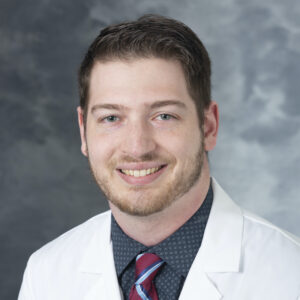Education
MS, Hofstra University, Medical Physics (2022)
BS, Binghamton University, Mathematical Physics (2020)
BA, Binghamton University, Mathematics (2020)
Selected Honors and Awards
Sigma Pi Sigma (National Physics Honor Society) (2019)
Boards, Advisory Committees and Professional Organizations
American Association of Physicists in Medicine (AAPM) 2021-Present
Twitter: @SBlumPhysics
What are your Clinical & Research Interests?
Brachytherapy, IGRT, SBRT for VT
Why did you choose to come to UW?
UW was appealing to me because of the staff- the professionalism, the friendliness, the knowledge, and the passion for the field and for teaching. Additionally, the equipment and lessons I would have available to me as a resided were top-tier. Not only this, but UW has a strong reputation in medical physics, and I wanted to be part of it. If there was a Mt. Rushmore of medical physics, UW would be on it.
Favorite part of residency, favorite rotation, or favorite thing about the program?
My favorite rotation is brachy! My favorite part of residency so far is really deepening my understanding of medical physics, learning more on how to be a safe clinical physicist, and getting experience using different systems, software, equipment, etc.
Favorite thing to do in Madison?
Definitely trying all the different restaurants
Fun fact about yourself or things you like to do for fun?
I played volleyball for 10 years (until I started grad school), I love watching sports, especially baseball and football, and exploring the city
-
Post-treatment Exposure Rates for <sup>90</sup>Y Microsphere Patients: A Comparison of Products Journal of nuclear medicine technology
Blum S, Silvestrini E, Weinstein J, Greben C
2022 Aug 30:jnmt.122.264335. doi: 10.2967/jnmt.122.264335. Online ahead of print.
-
More
There has been a significant increase in the use of yttrium-90 microspheres in treating liver malignancies. This increase can be seen over the last 30 years, and FDA approval of two products- SiRTeX SIR-Spheres and Boston Scientific TheraSpheres- has helped in the proliferation of these treatments. As the increase in use of both products rose- which is true at our institution- there was a need to determine if there should be special considerations for patients who receive one product compared to patients who receive the other product. This was investigated by measuring exposure rates for several regions of the patient before and after implantation. An independent samples t-test analysis (ɑ=0.05) was performed for a total of 50 patients (25 TheraSphere and 25 SIR-Spheres) to determine if the products behaved similarly to the extent that exposure to others is minimized and ALARA principles were kept. The results showed that the products exhibit no significant differences in terms of exposure rates, which suggests that there is no need for unique aspects of one procedure for one product compared to the other.
PMID:36041878 | DOI:10.2967/jnmt.122.264335
View details for PubMedID 36041878
-
More
